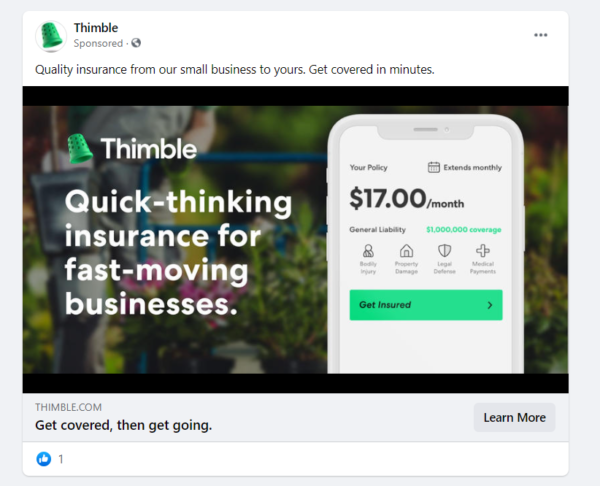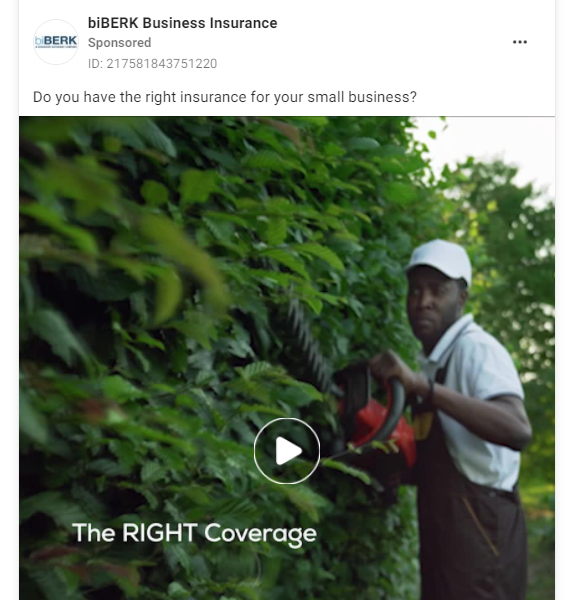
While TikTok, YouTube, and Instagram are huge influential players in the social media landscape, one of the most reliable platforms for marketing is still Facebook. About 2.89 billion people actively use this social network every month and many of them are in key demographics for a variety of insurance products. Facebook Ads for insurance agents can be an effective tool to capture new leads and generate new business.
How Facebook Ads for insurance agents expands your reach
Facebook appeals to a wide audience and, as an insurance agent, the platform can certainly help you broaden your reach with highly effective ads. About 28% of millennials and 29% of baby boomers use the internet to research and purchase insurance coverage, and a majority of them are Facebook users.
Market research indicates that most Facebook users — roughly 71.9% — are adults between the ages of 18 and 44. This segment consists of drivers, renters, and homeowners who may be looking for better, more affordable insurance options that your agency can provide.
While Facebook’s largest user group consists of males between the ages of 25 and 34, making up about 19% of users, women generally click on Facebook ads more often than men do. On average, Facebook users click around 12 ads per month. If any of these users are looking for affordable insurance coverage, your agency’s Facebook Ads might be the first thing they find when they search for options online.
Find more leads and drive policy renewals with expert marketing advice and all the tools you need, all in one place.
Facebook Ads basics
Not everyone who logs into Facebook daily spends their time clicking ads. Other popular activities include liking and sharing posts, interacting with friends through individual timelines and groups, and watching videos with the sound off.
People also use the site to research and interact with businesses. While you might already be using Facebook to share content with your current customers, Facebook Ads lets you expand this reach because your posts are shown to people who aren’t following you. The ads look like any other posts on a user’s timeline but they are listed as “sponsored.”
Types of campaigns for your objectives
Facebook Ads for insurance agents isn’t as simple as creating a post and choosing your target audience. You can create various ads depending on your goals and objectives.
Generating leads
One of the most common campaign objectives is to generate new leads. You can create Facebook lead ads that are targeted to people who don’t already know you and offer a compelling reason for them to go to your website.
Make them curious enough to click. Your lead generation ad should include copy that clearly conveys what you do and encourages people to want to learn more. When people click your ad, you can direct them to a landing page where they can sign up for more information.
Once you’ve got your new leads, keep in touch with them. Segment your email list, to help you keep track of how they heard about you and what they may be interested in learning more about, based on which ad they clicked.

Improving sales
Another potential goal for your Facebook Ads is to sell more policies. Just like you want to turn random internet users into potential leads, you also want to drive conversions and actually make sales. Your established brand might already have high levels of recognition. Using Facebook Ads lets you reach new and existing customers with more details about your products and services.
Photo ads with compelling copy, for example, can generate a need for what you’re selling, while a video ad can showcase how customers will benefit from your product or service. Highlight your most popular products to stir interest and drive customers to your website. When they land on your site, you can direct them to landing pages relevant to the ad they clicked on. These simple pages are accessed only through a direct link, and you can use them to bring readers directly to a page prompting them to sign up, register, or even purchase the product or service your ad highlighted.

Building customer relationships
Social media is one of the best marketing tools available for building client relationships. If your ad objective is to find new customers to engage with, create ads that show new users what they will get by joining your community.
Your ads should be similar to organic posts on your feed. Since your goal is to get new people to like your page and interact with you, your call to action should be geared toward connecting with your social media feeds. Include language such as “Join the conversation on Facebook.”
Your step-by-step guide to Facebook Ads
Step 1. Define your goals
Before grabbing your camera, define your goals. Often, Facebook marketing for insurance agents is done to generate new leads and drive traffic to your website.
Your goals will help you personalize your ads so they land more effectively with your target audience. If you aim to generate new leads, your ad may highlight the benefits of having different insurance policies and encourage people to sign up for your email list.
You might want people to download your app, making it easier to manage payments and claims. In this case, you could create a video ad that details the benefits and features of your app with a link that lets people download it.
If you’re sponsoring a local charity event, use Facebook Ads to drive attendance. To achieve this goal, your message would revolve around the organization with a call to action to encourage people to buy tickets or register.
Step 2. Set up your Facebook Business account
You might already have a Facebook Business account to interact with existing customers. In this case, skip to step three. If you don’t have a Facebook Business account, set one up. Choose a relevant profile picture that makes it easy for users to identify your business. Most insurance agents use a professional headshot or company logo.
Write a detailed description of your business, including the types of policies you offer. If you sell life insurance, homeowner’s insurance, or car insurance, for example, list this information in your profile.
Add your phone number, email, and hours of operation. Make it easy for clients to contact you directly from Facebook by adding a contact button to your profile.
Step 3. Create your ad
Your goals will let you design a compelling ad with interesting visuals. Use your phone to shoot a brief video that drives people to your website to learn more about insurance. Or use a graphic design platform to create a photo with an overlay of ad copy.
Step 4. Visit Facebook Ads Manager
In the Facebook for Business platform, choose the option to create an ad. Facebook lets you set your objective from a multiple-choice list so it can better target clients. Next, select your audience. You can define them by location, demographics, interests, or other criteria.
Once you’ve selected your audience, decide where to run your ad. If you’re not sure of the best channel, just click Automatic Placements. Then, set your budget, choose your format, and place your order.
If you’re a Constant Contact customer, you can create and run your Facebook Ads right from your Campaigns dashboard.
Step 5. Measure your returns
When you’ve published your Facebook Ads, you can use Facebook Ads Manager to measure its success. Use this data to tweak your ad strategy. Over time, you will learn which messages and channels get the best results, and you can start creating more successful ads.
If you published your ad via Constant Contact, you can view the results of your ad by clicking on the campaign, just like you would check the results of an email campaign!
10 tips for insurance agents running Facebook Ads
Make your Facebook Ads for insurance agents more successful with these tips and best practices.
1. Do some competitive analysis
Scroll through your own Facebook feed to see what kinds of ads your competitors are posting. If you don’t see any ads in your feed, search for sponsored posts. Also, look at other insurance agent pages and make note of which posts get the most engagement. It’ll probably be different on each page, but it can help you generate ideas for your own ads.
2. Select your target audience wisely
You can target your ads in multiple ways. Use your goals to determine the best custom features. If you’re interested in finding clients in your area, start by picking your audience by location. To appeal to people who don’t know you, try targeting different interests like small business owners or new parents.
Choosing the right audience helps boost your click-through rates. When you input accurate data, Facebook’s algorithm places your ads in front of the users you want to target. If your first ad doesn’t perform as you’d hoped, keep playing with different target audiences until you find what works.
3. Use high-quality photos
People won’t click on an ad if it features a blurry image. They also won’t click on an ad if they can’t tell what it’s selling. Some of your ads’ success will depend on the pictures you choose. Pick photos that are related to your insurance products.
If you’re running a Facebook campaign targeting young men for car insurance, use a dramatic photo of a beautiful car that was just in an accident. Make sure it’s not too graphic, just that it shows what kind of damage an accident can do to your favorite car.
There are plenty of resources online for high-quality stock photos you can use for free or for a small fee. You don’t have to go out and shoot every pretty house in your area or hire a photographer to get good photos. But, if you’re using stock photos, make sure you have permission to use them in ads.
If you are taking your own photos, use good lighting and keep the setup simple. Showcase houses, cars, and other commonly insured items. Whatever you’re photographing, make it stand out from the background.
Most smartphones nowadays have cameras that create high-quality pictures. Use yours to compose pictures that make people want to click.
4. Run some tests
Since you can set your own budget with Facebook Ads, start small and test a few first. Create two similar ads with slightly different messages and create a $5 campaign for each ad. Measure the results against each other to see which is the most successful.
Test campaigns are also good for narrowing down your target audience. You can run the same ad but target different people and measure the results to see which was the most successful.
The ability to test Facebook Ads against each other and see the results in real-time is one appeal of the platform. You can use the data from your tests to refine future messages and pick your various target audiences and platforms.
If your goal is to attract new customers, for example, you might run one ad based on location and demographics and run another ad based on demographics and interest. You will be able to see which ad generated the highest click rates.
5. Integrate your Instagram
Facebook owns Instagram, so you can manage ads on that platform through Facebook Ads Manager (or your Constant Contact account) as well. When choosing placements, you can pick Facebook and Instagram. Try running some of your ads on both platforms to see how they appeal to different audiences.
If you’re posting ads to Instagram, make sure your photos are formatted to look good as a square. Instagram posts display that way, so crop your photo and see if any relevant parts of the photo end up disappearing.
6. Use existing posts
Facebook lets you create ads out of existing posts. If you have an organic Facebook post that got a lot of likes and shares, turn it into an ad. You don’t have to start from scratch with each campaign. Sometimes your existing content is good enough. Modify it with a call to action in the description and use it in a new ad campaign.
In Ads Manager, there’s an option to “use existing post.” When you choose this option, Facebook shows you posts you’ve created. Click one and build your ad.
7. Mind your branding
Your website and business cards are likely branded with a distinct logo, fonts, and colors. These branding elements should carry over into your Facebook Ads. If you’re using color blocks to overlay text on an image, keep it in the same family as your website and other printed materials.
Create your copy using a font that matches the one on your website and business cards. If you’re an agent for a large insurance company, check out their branding guidelines. You might get access to templates that make the ad process easier.
8. Create timely ads
Facebook Ads for insurance agents is a great way to tie marketing into each season. Use your ads to appeal to people at various times of the year and sell common products in creative ways. For example, you could post an ad in the summer about upping homeowner’s insurance coverage in case of pool accidents.
If you’re in a cold climate with winter hazards, create a video ad at the beginning of the winter season with driving tips for snow and ice. At the end, tell people to call your agency and ask about car insurance.
9. Include a call to action
Each of your Facebook Ads should have a goal that will help you craft your call to action. If your goal is to get people to contact you, the call to action might be “call us today and find out how we can help.” To generate new leads, create a call to action telling people to sign up for emails and include a link to your sign-up form.
Your ad should leave viewers in no doubt of what they need to do next.
10. Use your analytics
Analytics are good for testing different markets and messages. You can also use them to keep improving your Facebook Ads. Small test ads will give you an idea of how to create and target ads for a larger campaign. But you can also use them to measure your campaigns when they’re complete.
Analytics can give you an understanding of what works and what doesn’t. If you noticed a certain ad that didn’t track as well as you thought it would open it to see where you might have gone wrong. Was the image less dynamic than you thought? Did you bury your call to action in the copy? Did you target the wrong audience?
These tools will help you create better ads in the future that more successfully achieve your desired response.
Where to begin
If you’re ready to start running Facebook Ads for your insurance agency, start by defining your goals. Make a list of what you’re already doing to market your company and figure out how Facebook Ads can fit in. This will help you solidify your goals.
Next, create a Facebook Business profile if you don’t already have one. If you do, pick a small budget with a limited target audience, and start testing ads. Create campaigns for different audiences or slightly tweak your copy in one ad.
The beauty of Facebook Ads is that they’re effective and user-friendly. Your ability to set small budgets lets you try new tactics without spending all your marketing dollars on one ad. Start small and soon you can use Facebook to attract new business to your agency.




